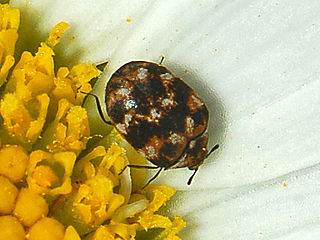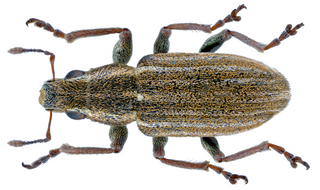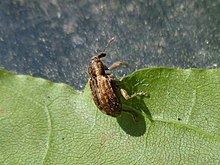
Aestivation is a state of animal dormancy, similar to hibernation, although taking place in the summer rather than the winter. Aestivation is characterized by inactivity and a lowered metabolic rate, that is entered in response to high temperatures and arid conditions. It takes place during times of heat and dryness, which are often the summer months.

Megachile rotundata, the alfalfa leafcutting bee, is a European bee that has been introduced to various regions around the world. As a solitary bee species, it does not build colonies or store honey, but is a very efficient pollinator of alfalfa, carrots, other vegetables, and some fruits. Because of this, farmers often use M. rotundata as a pollination aid by distributing M. rotundata prepupae around their crops. Each female constructs and provisions her own nest, which is built in old trees or log tunnels. Being a leafcutter bee, these nests are lined with cut leaves. These bees feed on pollen and nectar and display sexual dimorphism. This species has been known to bite and sting, but it poses no overall danger unless it is threatened or harmed, and its sting has been described as half as painful as a honey bee's.

Leptoconops torrens is a species of small biting flies in the no-see-um family Ceratopogonidae. They were first mentioned in writing by Charles Henry Tyler Townsend in 1893. The name Leptoconops carteri is a junior synonym of L. torrens. They are prevalent in the southwestern and southeastern areas of the United States. In early stages of life, L. torrens flies dwell in soil, then emerge to feed and breed as fully developed adults.

The varied carpet beetle is a 3 mm-long beetle belonging to the family Dermestidae, positioned in subgenus Nathrenus. They are a common species, often considered a pest of domestic houses and, particularly, natural history museums, where the larvae may damage natural fibers and can damage carpets, furniture, clothing, and insect collections. A. verbasci was also the first insect to be shown to have an annual behavioral rhythm and to date remains a classic example of circannual cycles in animals.

The codling moth is a member of the Lepidopteran family Tortricidae. They are major pests to agricultural crops, mainly fruits such as apples and pears, and a codling moth larva is often called an "apple worm". Because the larvae are not able to feed on leaves, they are highly dependent on fruits as a food source and thus have a significant impact on crops. The caterpillars bore into fruit and stop it from growing, which leads to premature ripening. Various means of control, including chemical, biological, and preventive, have been implemented. This moth has a widespread distribution, being found on six continents. Adaptive behavior such as diapause and multiple generations per breeding season have allowed this moth to persist even during years of bad climatic conditions.

Manduca quinquemaculata, the five-spotted hawkmoth, is a brown and gray hawk moth of the family Sphingidae. The caterpillar, often referred to as the tomato hornworm, can be a major pest in gardens; they get their name from a dark projection on their posterior end and their use of tomatoes as host plants. Tomato hornworms are closely related to the tobacco hornworm Manduca sexta. This confusion arises because caterpillars of both species have similar morphologies and feed on the foliage of various plants from the family Solanaceae, so either species can be found on tobacco or tomato leaves. Because of this, the plant on which the caterpillar is found does not indicate its species. The caterpillar is highly toxic and can cause major swelling if touched.

Cyrtobagous salviniae is a species of weevil known as the salvinia weevil. It is used as an agent of biological pest control against the noxious aquatic plant giant salvinia.

Sitona is a large genus of weevils in the family Curculionidae native to the Nearctic and Palaearctic regions. Over 100 species have been described. Sitona is easily distinguished from related genera by flat, recumbent scales on the mandibles, by the absence of an oval scar on the mandibles, by short and broad rostrum with a deep, longitudinal, median groove, and by dense scales on the body.

Oxyops vitiosa is a species of weevil in the family Curculionidae. Common names include the melaleuca leaf weevil and the melaleuca snout beetle. It feeds on the leaves and shoots of the broad-leaved paper bark tree, Melaleuca quinquenervia, which is endemic to Australia where it grows on seasonally inundated plains and swampland, and was introduced into Florida in order to help drain flooded portions of the Everglades.

Apoderus coryli, the hazel-leaf roller weevil, is a species of leaf-rolling beetles belonging to the family Attelabidae subfamily Attelabinae. Because of the trunk-like elongated head, it is often mistakenly attributed to the weevil family Curculionidae.

Curculio elephas is a species of beetle in the family Curculionidae, the true weevils. It is known commonly as the chestnut weevil. It is a serious pest of chestnut in Europe.
Aphidius nigripes is a species of parasitoid wasp in the subfamily Aphidiinae of the family Braconidae. It is the most common parasitoid of the potato aphid Macrosiphum euphorbiae in eastern North America. Many other species of aphids may also serve as hosts.
Anaphes nitens is a species of fairyfly, a chalcid wasp in the family Mymaridae. Native to Australia, it is an egg parasitoid of the gum tree snout beetle, a pest of Eucalyptus trees, and has been used in biological pest control of that species.

Hypera nigrirostris, commonly known as the lesser clover leaf weevil, is a species of weevil that is native to Europe and northern Africa and has been introduced to North America and Japan. Both adults and larvae feed on red clover and other plants in the family Fabaceae.

Sitona lineatus, commonly known as the pea leaf weevil is a species of weevil with a Palearctic distribution. It is a common pest of beans, peas, and other plants in the family Fabaceae. Adult beetles of S. lineatus measure 3.4-5.3 mm in length. They are characterized by a series of colored scales arranged in alternating lines (striae) on the elytra; it is from this characteristic where the species gets its name lineatus meaning 'lined' or 'striped'. The head and pronotum also have fine pointed setae amongst the scales. The antennae are clubbed, pointed and preceded by 7 segments. The femora is dark, but tibiae and tarsi are red. As a member of Order Coleoptera (beetles) their forewings are modified to form hardened covers over the thorax and abdomen, with the hindwings for flight underneath.

Ceutorhynchus obstrictus, the cabbage seedpod weevil, is a species of snout beetles or true weevils which is widespread in Europe and lives on several types of crucifers. The adult weevils feed on the leaves, but breed in the seedpods, where the larvae destroy the seeds. It can be a harmful pest on crops like rapeseed/canola, cabbage and relatives or Brassica rapa.
Trichobaris trinotata, commonly known as the "Potato stalk borer", is a species of weevil in the family Curculionidae. It is found in North America where it is a pest of potato plants, the larvae tunnelling inside their stems.
Cylindrocopturus adspersus, the sunflower stem weevil, is a species of true weevil in the beetle family Curculionidae. It is found in North America, where the larvae tunnel in the stems of wild and cultivated sunflower plants.
Nealiolus curculionis is a species of parasitic wasp in the family Braconidae. It is a parasitoid of the sunflower stem weevil Cylindrocopturus adspersus, and a number of other species of stem-boring weevils.

Odoiporus longicollis, commonly known as banana stem weevil or banana pseudostem borer, is a species of weevil found in South Asia and South East Asia.
















